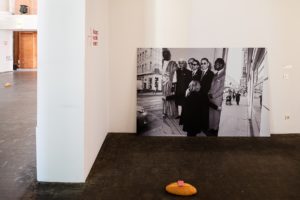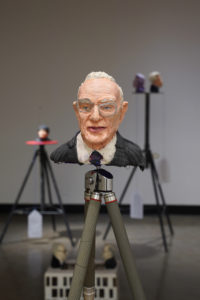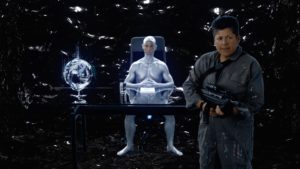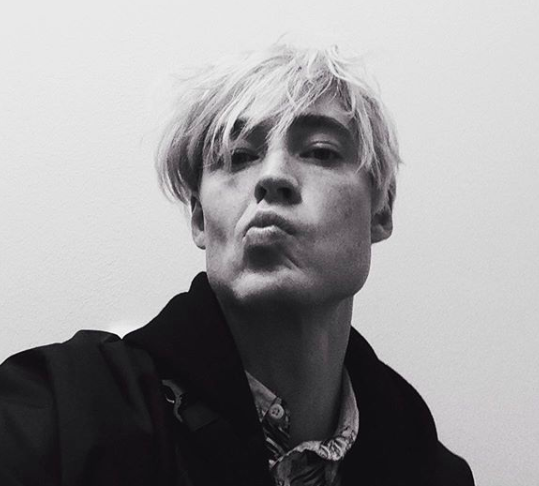“…of bread, wine, cars, security and peace”
“…of bread, wine, cars, security and peace,” Kunsthalle Wien Museumsquartier, Vienna, March 3– October 4, 2020

Adji Dieye, Maggic Cube, 2016-2019. Photograph. Kunsthalle Wien. Courtesy of the artist.
Exhibition titles often say a lot about an exhibition. Curators like to borrow a beguiling fragment of wording from an author or adopt a guiding idea that frames how we read the exhibition. Certainly the two texts that provided the theoretical backbone for the exhibition “…of bread, wine, cars, security and peace” recently on view at the Kunsthalle Wien Museumsquartier are telling. The first text is a book by Lebanese poet, essayist, journalist, and artist Bilal Khbeiz, Globalization and the Manufacture of Transient Events(Bilal Khbeiz, Globalization and the Manufacture of Transient Events (Beirut: Ashkal Alwan, 2003).), parts of which are excerpted in the exhibition catalog and were mounted in vinyl print on the gallery walls. The second text is Cruel Optimism by literary scholar and cultural theorist Lauren Berlant about why chasing the “good life” might be holding us back.(Lauren Berlant, Cruel Optimism (Durham, NC: Duke University Press, 2011).) Both Khbeiz and Berlant meditate on our dogged pursuit of impossible dreams, or at least dreams that have not materialized after decades of neoliberal policies. Both texts critique our temptation to believe in narratives of individual agency to overcome globalized phenomena. Many of the works in the Kunsthalle Wien exhibition questioned why capitalism fails to bring us closer to the good life, and why we blame ourselves in the face of irrefutable evidence that the system is providing an uneven playing field.
The exhibition title, “… of bread, wine, cars security and peace,” directly quotes Khbeiz, who deliberates the difference between the dreams of people in the Global South and the Global North. For Khbeiz, the titular list – bread, wine, cars, security, and peace – defines an idea of the good life that is unattainable for much of the world. In Cruel Optimism, Berlant, who is most known for her publications related to affect theory, similarly observes the unsatisfactory notion of the present – the failure of liberal democracies to deliver on the promises of individual mobility, security, and equality. Berlant’s text focuses on the persistence of the American Dream as a kind of cruel optimism, or a pathology when the things you desire work against your own interest. Writing from a global perspective, Khbeiz enriches the critical perspective carved out by Berlant when he considers the Global South’s subjectivity in asking the same questions about the good life.
The curators What, How & for Whom (WHW) respond to both texts in the exhibition catalog:
“Almost two decades after the publication [of Khbeiz’s text] it seems that these basics begin to escape more and more people living in places where they were once taken for granted: climate change puts the continuation of life on earth under question; ecological destruction gathers pace; faith in the benevolence of capitalism was broken by the 2008 crash, and its horizon of slow global improvement and trickle-down benefits is steadily evaporating.”(Ivet Ćurlin, Nataša Ilić, and Sabina Sabolović, eds. “…of bread, wine, cars, security and peace,” exhibition catalog (Vienna: Kunsthalle Wien, 2020), 3.)
Both the catalog and general choice of material in the exhibition demonstrate WHW’s loss of faith in capitalism through the works of some thirty-five international artists who have inspired the collective since their beginnings in Zagreb. In fact, the collective’s name What, How & for Whom comes from Karl Marx’s The Communist Manifesto where Marx refers to the economics of the means of production. The exhibition at Kunsthalle Wien opened on International Women’s Day and follows WHWs practice of launching exhibitions on symbolic days. Their first exhibition in 2000, the title of which gave the collective its name, opened on the 152nd anniversary of the Communist Manifesto.
WHW consists of Ivet Ćurlin, Ana Dević, Nataša Ilić, and Sabina Sabolović. Only Ćurlin, Ilić, and Sabolović work as the Kunsthalle Wien’s new directors, however they still see themselves as a collective furthering their belief in collectivity as an ideological choice. The fourth member, Ana Dević, continues Galerija Nova, the space WHW set up in Zagreb in 2003, where since the mid-1990s WHW has contributed to building the contemporary arts scene in Zagreb.
The collective’s curatorial focus is often on social and ecological reproduction, as well as reckoning with the ways in which the work of serving others has been shaped by gender and race. Remaining closely engaged with Marxist theorization, WHW adopts an anti-capitalist position and identifies with Alain Badiou’s radical egalitarian politics.
“…of bread, wine, cars, security and peace” was a remarkable international group show intended to give visitors an idea of their artistic and political interests. Nothing was spared in terms of space: the exhibition took place in all of the Kunsthalle Wien’s affiliated venues and beyond, including performance events at the infamous Kasino associated with the palatial Burgtheater. The exhibition was also distinc for the city of Vienna and for the renowned institution after the controversial resignation of its previous director Nicolaus Schafhausen in 2019. Schafhausen’s early departure was marked by a public letter explaining his decision in which he argued that the Kunsthalle’s programming faced opposition from the country’s new coalition government. [In December 2017, Austria became the only country in Western Europe to have a far-right presence in government.] “Advanced experiments in the arts are increasingly constrained” in the current political climate, Schafhausen stated, adding that cultural institutions across Europe that engage with complex societal issues “will require substantially stronger political backing in the future.”(Artforum News, “Citing the Resurgence of Nationalist Politics, Director of Austria’s Kunsthalle Wien Resigns,” Artforum, May 23, 2018, https://www.artforum.com/news/citing-the-resurgence-of-nationalist-politics-director-of-austria-s-kunsthalle-wien-resigns-75545.)
The Eurocentric focus of such concerns seemed to cast an eerie shadow over the attempt at a fresh start with more global perspectives from the Kunsthalle’s new directors from Zagreb. To some extent, the Kunsthalle Wien has now become a place to observe the shift in civil society and to gauge if and to what extent art can be a tool of resistance. The decision to follow Schafhausen’s departure by installing not only a new director, but a collective from the Yugoslav minority of the former Hapsburg Empire is itself a statement by the city of Vienna, which funds the Kunsthalle and continues to be led by Social Democrats despite the federal government’s shift towards the right under Chancellor Sebastian Kurz.
While WHW wants to open up the house metaphorically and literally, the exhibition’s large physical reach tested the threshold of the general public’s ability to understand the exhibition in its entirety, if at all. Likewise, the range of practices made the exhibition seem more like a biennial then one show with a coherent curatorial intention, thus the Viennese public might have had difficulty grasping a coherent sense of the curators’ aesthetic style. Even if visually unclear, the exhibition’s politics were not, as it took a critical position against the legitimacy of capitalism’s viability to provide the good life.

Mladen Stilinović, For Marie Antoinette ’68, 2019. Installation. Kunsthalle Wien. Image courtesy of Branka Stipančić, Zegreb. Photograph by Jorit Aust.
The exhibition was frantic and wildly put together with no single visual motif discernably threading together the massive exhibition space in Kunsthalle Wien. Instead of architectural interventions throughout the Kunsthalle, loaves of bread were placed on the floor to guide visitors. The loaves were actually a series of conceptual art installations by Mladen Stilinović. Cheekily titled For Marie Antoinette ’68, the work is a sculptural translation of the queen’s infamous phrase “Let them eat cake,” in which Stilinović placed cakes and cobblestones on top of cheap loaves of bread. The installations themselves were faint, delicate, and totally succeeded in pulling the exhibition together physically and thematically critiquing a ruling class so colossally out of touch with reality that it by no means seems fit to govern.
The state’s inability to fulfill even the basic dreams of the individual are important to this work and the exhibition as a whole. The ruptures that have diminished socially progressive values and ideas of the good life are laid bare in Stilinović’s trail of bread. The germaneness of the installation is obvious, as the legalization of the 12-hour workday effected in September 2018 in Austria seems out of step with the kind of utopian thinking the exhibition and its curators propose. In response to Schaffhausen’s skepticism as to whether the Kunsthalle could be a place for political gesturing, the curatorial statement by WHW says the exhibition: “celebrates sustaining and improving human life, as well as the lives of other species who share our world. It proposes a daily life that is less arduous and more pleasurable, with an abundance of communal luxury and collective leisure, where the “good life” is ecologically supportive and oriented toward the flourishing of all.”(“…of bread, wine, cars, security and peace,” exhibition catalog, 5.)

Andreas Siekmann, Heads (Detail), 2019-2020. Installation. Kunsthalle Wien. Image courtesy the artist & Galerie Barbara Weiss, Berlin. Photograph by Kunsthalle Wien.
If many of the works fail to orient themselves towards a utopian flourishing, then they succeed in satire. Works byartists from both the Global South and Global North deal squarely with Khbeiz and Berlant’s speculation on the good life, including Andreas Siekmann’s Heads (2019-2020), Adji Dieye’s photographic series Maggic Cube (2019), and Tuan Andrew Nguyen’s poetic two-channel film My Ailing Beliefs Can Cure Your Wretched Desires (2017). The Berlin-based Seikmann’s installation of forty-seven busts of the wealthy fathers and mothers of capitalism displays a genealogy of the neoliberal capitalist system –a system that has increasingly managed to dominate the entirety of life with its seemingly never-ending push for privatization. The cast of characters ranging from Margaret Thatcher to Friedrich Hayek are comically represented in children’s plastiscine. Some even take roles in an accompanying stop-motion film, the unfinished quality of which befits an ironic and childlike presentation. Seikmann’s work points out how fragmented and unbalanced the proposals that have guided the neoliberal age have been.
There is a certain criticality towards unchecked global market forces that pervades many of the works in the exhibition. Artists Dieye and Nguyen are wary of unchecked free-market thinking, and their works explore our Sisyphean pursuit of the good life as either a probing of the colonial legacy of popular cooking products or a disturbing interspecies evaluation of our obsessive patterns of consumption.
For both, assiduous reproach is rejected in favor of a charming use of materials to subject their studies to a scrutinous eye. Dieye subverts advertising tropes parodying those made by the Swiss bouillon cube manufacturer Maggi by employing aesthetics that take hold of the direct, simple language of advertising. The nearly life-size portraits display women of color posing in traditional West African dresses. Some works are a mix of multilayered archival photos imposed on freshly painted backgrounds. The costumes and general palette of the collaged images are made up of the same arresting yellows and reds used in McDonalds’ and Maggi’s trademark logos. Some of the works have replaced African faces for non-black faces to jarring effect. Together, the works force the viewer to think about soup and the aggressive marketing of this product, as thirty-six billion Maggi bouillon cubes are sold annually in West and Central Africa alone. Dieye brilliantly addresses visual representation and commodification of identity, at the same time critiquing stereotyped gender roles associated with Maggi’s marketing.

Adji Dieye, Maggic Cube, 2016–2019. Photograph. Kunsthalle Wien. Image courtesy of the artist. Photograph by Jorit Aust.

Tuan Andrew Nguyen, My Ailing Beliefs Can Cure Your Wretched Desires, 2017. Film still. Kunsthalle Wien. Image courtesy of the artist and James Cohan, New York.
Where Deiye’s works focus on tertiary aspects of the meat industry, Nguyen’s My Ailing Beliefs Can Cure Your Wretched Desires questions the morality of human attacks on the animal kingdom. The film presents scenes of nauseating butcheries of animal carcasses alongside a compelling Socratic dialogue between the spirits of the last Javan rhinoceros and the mid-fifth century legendary Vietnamese turtle named Cụ Rùa. The reimagining of daily concerns and dreams from animal consciousness versus human needs for cars and bread makes Nguyen’s contribution an especially gripping one in an exhibition that can feel a little lopsided in terms of its focus on perspectives concerning the economy of the Global North. Nguyen’s contribution is a standout in the exhibition, and succeeds to find a meeting point between the Global North and South. The filmic sequences through Vietnamese slaughterhouses and wet markets offer a critical perspective on the global appetites, that feed the illegal hunting and trapping markets in the Global South.

Zach Blas, Contra-Internet: Jubilee 2033 featuring Cassils, 2018. Film still. Courtesy of the artist.
While many artists focus on aspects of the everyday, other artists look to science fiction or technology to explore the problematics of a globalized world. Zach Blas’s short film Jubilee 2033, inspired by filmmaker Derek Jarman’s queer-punk film Jubilee from 1978, presents a futuristic queer society rising from the ruins of a post-apocalyptic Silicon Valley. The film itself is part of Blas’s 2018 project Contra-Internet that confronts the growing hegemony of the Internet through installation, video, CGI animation, glow-in-the-dark text, blown-glass sculptures, and a single-edition publication titled The End of the Internet (As We Knew It). Blas’s work plays out one of the most startling of Khbiez’s observations about the difference between the developed and the developing world:
The dreams of the Third World are visible, tangible, felt and lived. So what about the dreams of the Americans? Most probably, and if the following historical comparison is allowed, there is a classist segregation of dreams. Science fiction is a specialty of developed societies, while we in the Third World are left to dream of bread, wine, cars, security and peace.(Bilal Khbeiz, “Globalization and the Manufacture of Transient Events,” in “…of bread, wine, cars, security and peace,” 6-7.)
Khbeiz’s observation that the so-called “haves” look to science fiction for either confirmation or inspiration, while the “have nots” look to realism is startling when one considers the success of the sci-fi television series Black Mirror and the renewed interest in dystopian authors Margaret Atwood and George Orwell. To suggest that Khbeiz’s separation of genres and subsequent followers isn’t painting things with a broad brush would be disingenuous. However, it is an excellent point of departure for a discussion about for whom such genres speak, how they do so, and why, questions similarly raised by Mark Dery, who coined the phrase Afrofuturism. In his essay “Black to the Future,” Dery asked why so few African Americans write science fiction, seemingly confirming Khbeiz’s reflections.
In the end, “…of bread, wine, cars, security and peace” was an exhibition that defied any easily defined associative platitudes. At every turn within the Kunsthalle, as well as throughout all the off-sites and associated talks and interventions, the public was forced to return to the legitimacy of Khbeiz’s observations. Whether through meditations on sci-fi dystopias or the importance of our daily bread, the exhibition critically investigated how we dream of the good life. For WHW, working full-time on two salaries, the good life remains a question of the kinds of means of production we either accept or reject.





